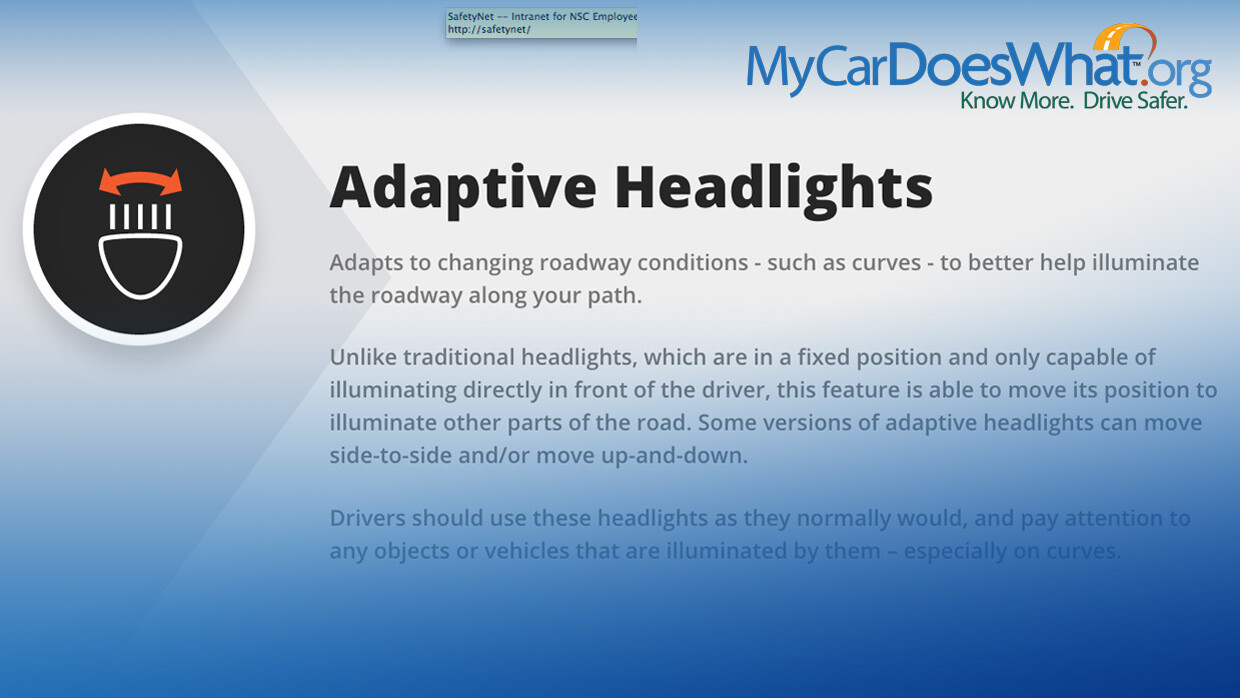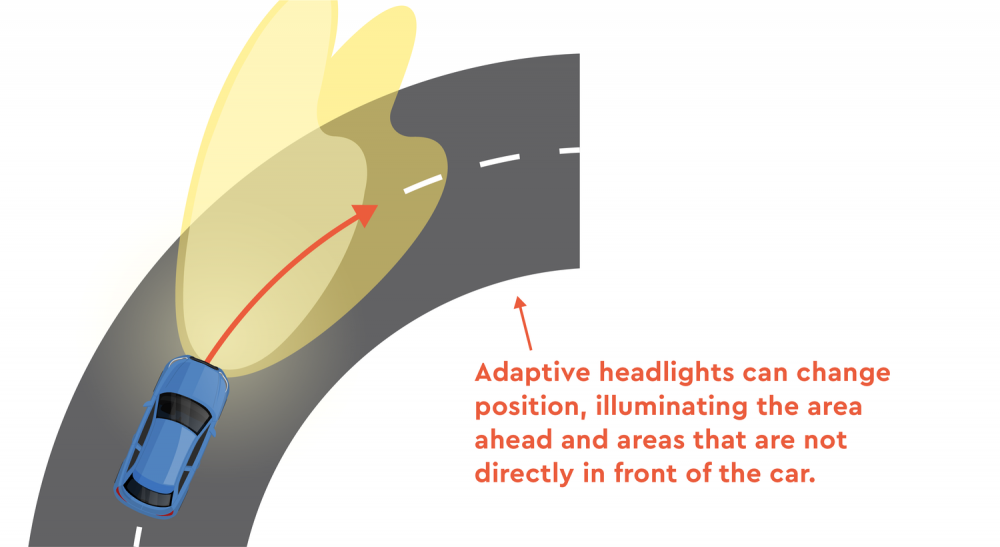Rev your engines and turn the lights on—it’s time to dive into the latest automotive upgrade you didn’t know you needed: adaptive headlights. Making night driving safer and navigating through curves seamless, these tech marvels are changing the nocturnal driving game for good. Buckle up as we illuminate the benefits and usage of this auto innovation, shedding light on how they’re steering us straight into the future of road safety.
Table of Contents
Understanding Adaptive Headlights

To lay the groundwork for the sophisticated technology under the hood (quite literally), consider adaptive headlights to be like your cheeky, intelligent little buddy who wants you to see better and be safer on the road. They’re indeed high-tech components of your vehicle and their prime task is to light up the road ahead, but they do it with a twist.
Unlike conventional static headlights, adaptive headlights swivel along with your car’s steering wheel. Think of them as nimble ballet dancers performing a pirouette in perfect symphony with your car’s movement. The purpose is to optimize the coverage of light on the road ahead, particularly on curves and bends where traditional headlights fall short.
Let’s get more specific with this ejemplo: Imagine you’re driving through a winding road late at night. As you steer your chariot left, the headlights swiftly and seamlessly veer to the left too, illuminating the curve ahead. Now, meet a hairpin bend on the road, the kind that could make even a seasoned driver break out in cold sweat. But here, your adaptive headlights rise to the occasion, rotating to help you visualize exactly what awaits around the bend.
The magic behind this smartness? Sensors. Sensors fitted onto the car relay vital information about the car’s speed, direction, and the angle of the steering wheel back to a control unit. Add to this, onboard computers and actuators, and these adaptive headlights literally get a life of their own, calculating and adjusting the optimal direction and angle of the headlights.
However, it’s JavaScript-not Dr. Frankenstein-kind of life. As the car eases into a turn, these inputs make the system pivot the headlights. The system also uses speed data to adjust the beam’s depth: as the car goes faster, the control unit directs the beam farther down the road, while slower speeds cause the lights to drop their gaze closer to the car. Quite sophisticated, yes?!
So, these brilliant bulbs bring a whole new level of intuitiveness when it comes to car lighting. A word of caution though – don’t expect these lights to look around corners. They are smart but not psychics, so they respond to current car inputs and not the unforeseen ones.
In the world where cars are increasingly becoming smarter and driver-friendly, adaptive headlights have emerged as a crucial technology, revolutionizing the way we drive and perceive safety on the roads. As they say, the future is bright, and it swivels to the right…or left.
Advantages of Using Adaptive Headlights

Adaptive headlights, in simple terms, are like having a touch of Spiderman’s agility or Superman’s sharp vision. Rather than remaining stationary, these headlights adjust their beam direction according to your car’s speed, steering angle and even the pitch of the road. Now, if that isn’t downright superhuman, I don’t know what is.
We’ve certainly come a long way from traditional headlights that only serve to combat darkness. Adaptive headlights bring along a buffet of benefits, almost enough to make you feel like your car is speaking a different, sophisticated language. The chief advantage is, of course, enhanced visibility. As you steer your vehicle and traverse the maze of curves on the road, your adaptive headlights are your trusty companions. They take the guesswork out of the equation, illuminating the path ahead in accordance to your vehicle’s movements.
The second perk is an amplified sense of safety, and who doesn’t appreciate a bit more security within their four wheels? With the additional visibility, there’s a higher chance you’ll spot the deer that’s decided to take a midnight jaunt across the road. Or the kid who has made a sprint for his wayward soccer ball. You are now less likely to be surprised by these unexpected elements.
Adaptive headlights don’t just look out for you, they also spare a thought for your fellow drivers. They’re designed to dip their beams when an oncoming vehicle is detected, preventing blinding glare from unsettling other road users. In a sense, they’re both protective and well-mannered—quite the dashing combo if you ask me.
Lastly, let’s not forget the potential reduction in fatigue. Night-time driving can be quite the Herculean task with constantly adjusting your eyes to changing light conditions. Your road-hero adaptive headlights can be a significant help in easing this burden. They could make the difference between a tiring drive and arriving at your destination relatively fresh.
With these upsides, adaptive headlights are an autobahn unto themselves, leading the way towards a future where night-time driving feels a lot less like tiptoeing in the dark. How’s that for interactive illumination?
How to Use Adaptive Headlights

Adaptive headlights are questionable game-changers for the illumination game. These charming lumps of tech aren’t content to just stand by, blasting their light indiscriminately like some halogen lout. Oh no, they’re sophisticated, elegant dames of the night, bending and flexing with the curves of the road like a ballet dancer. They literally shine a light on your path, making night-time driving a less perilous task.
But driving with them is another animal altogether. Your average driver moseying about, going through their day, is likely to be asking: “How do I even use these adaptive headlights?” Well, dear reader, let me guide you through the charmingly-bizarre world of high-tech illumination.
To begin your journey into this brave new world, you need a car equipped with these adaptive headlights. These aren’t some aftermarket, bolt-on kit you can slap on your ’78 Ford Pinto. No, they usually come from the factory, as an option on premium vehicles or the latest models. Check your user manual, it’ll usually guide you on whether your ride possesses this prestigious attribute.
Now, posture yourself in the driver’s seat and look around – no, not for your phone or snacks – for a button or switch, typically located on your car’s multifunction control stick, the same one that allows you to signal a turn or adjust your high beams. Hover your attention to a button possibly labeled “AHL”, “Adaptive Lighting”, or a representation of a curvy road with a shining light. If you spot it, congratulations, you’ve found the magic portal to futuristic illumination!
Bear in mind, not all systems are alike. Some automatically turn on when you start the car, with no need for you to push any button. Others, however, wait for your input, obeying your wish at the push of a button or twist of a dial. To be sure, consult your trusty user manual.
Once activated, the adaptive headlights work the beat on their own. They swivel left or right, following the movement of your steering wheel, focusing their luminous attention on the road ahead. Some even adjust their beam, casting the light down when oncoming traffic is detected, preventing you from becoming that one blinding obstruction on the road.
Finally, be aware that adaptive headlights typically only function when your vehicle is moving, and usually at speeds above 15 or 20 mph. This is not some defect, but an intentional feature to only come alive when they’re truly needed.
And there you have it—your journey into how to use adaptive headlights. Drive with confidence, batting your adaptive, bright eyelashes at the dark and winding road ahead. Remember, knowledge is not only power but also a light in a literally dark place. Drive safe, and be the master of your adaptive headlights! Trust me, they’re better company on a dark night than a blaring radio and dubious road snacks.
Potential Issues & Solutions with Adaptive Headlights

Adaptive headlights are no doubt sporting a velocity of transformative technological benefits. They’re all about shared intelligence between the driver and the vehicle for a more perfect driving acquaintance. But as it is with most technologies, they may come with a few quirks – quirks which are symbiotic to growth and improvement.
The first hurdle is on the technical side. As the technology relies heavily on sensors, any damage, dirt, or blockage to these sensors can affect the efficiency of the headlights. For instance, they might fail to detect a bend or a vehicle approaching from the front. The solution to this is fairly straightforward, periodically ensure a proper maintenance regimen.
Next, some systems are too sensitive, resulting in the headlights swiveling with every minor steering input. This could be a cause for concern, especially on straight roads, as it might lead to an unnecessary diversion of the light beam. In such cases, re-calibration of the sensitivity in the adaptive lighting system could be necessary for optimal performance.
Another issue that some drivers have reported is how the headlights respond in adverse weather conditions. In a dense fog or heavy downpour, the beam direction could be influenced, which deviates from its set path. This could potentially affect visibility and hence driving conditions. Car manufacturers and technology developers are aware of these weather-related issues and are focused on developing adaptive headlight systems with improved weather detection capabilities.
Finally, cost can be a significant deterrent for many. While arguably, the safety advantages outweigh the higher initial cost, maintaining and replacing these advanced headlights can also come with a steeper price tag. Over time we may hope to see the cost of adaptive headlight technology decrease as it becomes more commonplace.
Trusting that you are now familiar with both sides of the coin, it’s essential to remember that while adaptive headlights have their potential issues, the solutions are not far-fetched. They provide greater visibility and reduce the risk of accidents. Besides, nothing worth doing is ever without challenges. With ongoing development in automotive technology, these kinks will continue to be ironed out, refining this awesome tech advancement for future road safety.
FAQs
What are adaptive headlights?
How do adaptive headlights benefit drivers?
How do I use adaptive headlights?
Conclusion
Adaptive headlights, with their ability to illuminate the road based on a vehicle’s speed and direction, are undeniably a game-changer. By enhancing visibility, they make driving after sundown less stressful and more secure. Even though these advanced systems might be more costly upfront, they ultimately offer sound return on your investment – a safer, smoother and superior driving experience. As technology continues to influence transportation, regular headlights will soon be rendered obsolete, making way for smarter, adaptive systems.
